Jonathan Santlofer is a seasoned painter and crime writer, but his book publishing in July from Penguin is unlike anything he’s done before. The Widower’s Notebook is a memoir about the loss of his wife, Joy, who died suddenly after an ambulatory surgical procedure. It’s the story of a marriage, a story of grief, and a story of holding on and letting go, told with sensitivity, honesty, and—atypical of memoirs about loss—humor.
Four years ago, Joy was lying on their living room couch, recovering from a knee surgery that she underwent the previous day, when she said she didn’t feel well. She called the doctor, who told her to wait for her scheduled appointment in four days. But not long after, Joy went into distress, unable to breathe, and Santlofer called 911. “Then there are sirens outside and the buzzer is sounding... and the fireman burst into the room,” he writes.
The paramedics went into full savior mode. Santlofer notes that he thought, “This can’t be happening—they are saving her—they are losing her—she will be ok—she is dying.” At the hospital with his daughter, Doria, he thinks: “I am no longer a helpless husband waiting to hear if my wife will live or die, I am also a helpless father.” Joy doesn’t recover; she dies that night in the hospital.
“I never intended to write this book,” Santlofer tells me. “For two years, I couldn’t even read. I was in the middle of my next novel, but I couldn’t work.”
He also couldn’t stay in the house, so every night he went out, and when he came home, he recorded, in black-and-white marbled notebooks, what had happened during the evening. “I felt out of my mind,” Santlofer says. “It was how I coped. I’d write out whole conversations.” He also removed all the photos from around the house and started to make drawings.
A year and a half later, Santlofer was invited to Yaddo, the Saratoga Springs, N.Y., artists colony whose board he is on. “I can’t leave,” he responded, but the program director, Candace Wait, encouraged him to come. “Yaddo is a healing place,” she told him.
Santlofer did go, with the intention of working on that crime novel he’d started before Joy died—a historical art-theft novel, half fiction, half nonfiction—but he couldn’t do it. Instead he began to transcribe his handwritten journals. And he kept drawing. He’d sketch in a notebook and then expand the sketch into a more finished drawing. When he was done, he had 80 drawings.
Santlofer told Elaina Richardson, president of Yaddo and a longtime friend, what he was doing, and she asked to read the notes. He gave her 20 pages, and when she told him that she couldn’t stop reading and encouraged him to write the story, he says he felt that “if it affected someone else, it could actually be something.” He adds, “Elaina’s enthusiasm was key. I realized I had to step back and look at the notes as art, and wondered if I could do that. I made art decisions as well as truth decisions, and it was scary. This is a really personal book.”
Santlofer says he knew how different the project was from fiction. Once it felt like a book, he knew “it had to be the best thing I’d ever done.” And he knew he had to whittle it down: “If I had used everything in the notebooks, it would be Ulysses.”
Santlofer gave the book to Vanity Fair founding editor Pat Towers, who gave him notes, and Eva Orner, a documentarian, connected him with her agent, Todd Shuster at Aevitas Creative, where Jane von Mehren worked on the manuscript. It was sent out with the drawings and sold to Kathryn Court, the president and publisher of Penguin Books, who chose 12 drawings for the final book. Court calls the memoir The Year of Magical Thinking from a man’s point of view.
Men don’t often write grief memoirs. “When I started reading grief memoirs, I became aware that men don’t like to explore their emotions,” Santlofer says. “But, ultimately, I did not write for an audience. I want people to read this and not feel alone in their own grief.”
The reactions to the book, Santlofer says, have been touching and gratifying. The Widower’s Notebook is about crying and laughing. “I didn’t know these things could be funny,” Santlofer says, but a friend assured him that the story of an ill-fated sexual romp was very funny.
The friend was referring to an episode in the book that takes place a year after Joy’s death, in which Santlofer began an affair with a years-younger former student, dismissing the fact that she had a live-in boyfriend. One evening, while Santlofer was lying naked in bed with her, the boyfriend showed up, sat on the bed chatting, and then asked to join them (while removing his jeans). Santlofer writes, “There’s a bit more to the night (like bolting across the room, tugging on my pants, shoving my underpants in my pocket, stepping into shoes without socks).” Joyce Carol Oates calls it his “Nabokov chapter.”
Santlofer’s conclusion is that death is absurd and that grief books make people feel connected to the larger world. Grief books teach those who are grieving, he thinks.
Santlofer is also, he says, forever grateful for that time at Yaddo. “I got on the highway and felt a huge weight lift. I was happier there than at home.”
And that art-heist novel? Five years later, it’s almost finished. “The big time gap served me well,” Santlofer says, “because I saw things I don’t think I would ever have seen without the break.”



 Volume 265
Issue 26
06/25/2018
Volume 265
Issue 26
06/25/2018





